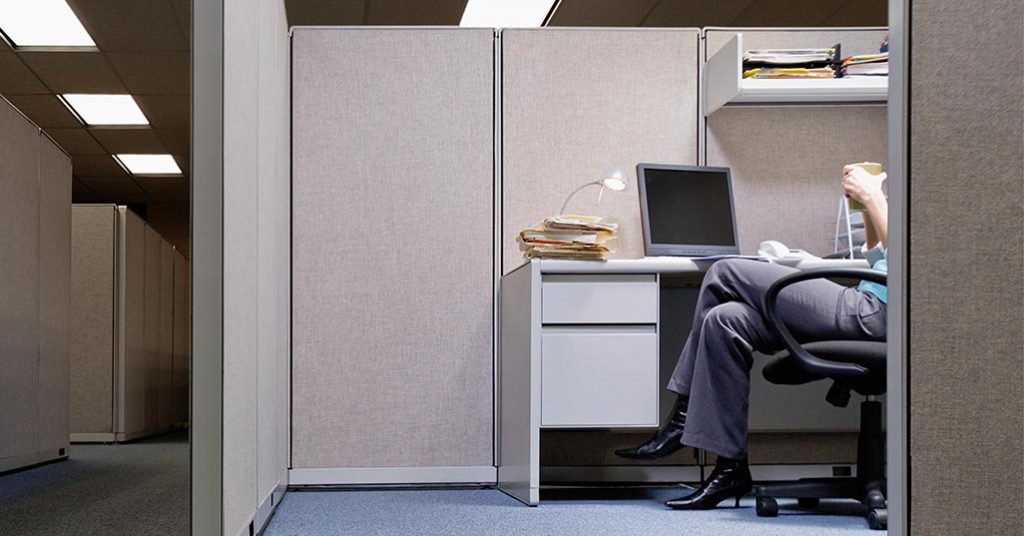Typical office workers spend about a quarter of their day inside — and if your workplace (cubicle, warehouse, laboratory, home office) has no windows, your body goes into “hibernation.” Lack of sunlight can produce nasty side effects such as depression, lethargy, heart disease or decrease in productivity.
Here’s some options for things to you can do to combat the windowless blues.
Take a break outdoors
You know that 15-minute break you get between the morning arrival and the highly-anticipated lunch break? Those few minutes you have to yourself before it gets busy again? Lunch break? Take it outside. In fact, any chance you get to take a brief break outside — sunshine or not — will vastly improve your mood, health, and productivity.
According to a 2014 study, conducted by Dr. Mohamed Boubekri, on the impact of windows and daylight exposure on office workers, workers in windowless workplaces reported lower scores in sleep quality and vitality, compared to their counterparts working at a workplace with regular sunlight exposure. The group exposed to more sunlight also reported longer and higher quality sleep patterns and increased physical activity.
Sunlight exposure can make you more productive, happier and healthier! So, just as you would set an alarm in the morning to start your day, set alarms throughout the day to step outside for a few minutes. If you plan on eating out with colleagues, encourage them to find a seat outside or take lunch to a nearby park or cafe to take in those precious sun rays!
Of course, there’s a little more to it than stepping outside in the daylight. According to the World Health Organization, in order to get the full benefits of the sun’s vitamin D-boosting benefits, your skin must be fully exposed to the sunlight — that means no long sleeves and sunscreen. However, you only need 5 to 15 minutes of sunlight, so harmful UV rays are negligible, so don’t sweat it (not too much, at least!)
Eat your way to sunlight
You can’t always get the corner office with the best views or step outside whenever you please to catch a breeze or a quick sunbathing session. Your skin is designed to produce vitamin D when exposed to sunlight. But when sun exposure is limited, particularly during the colder months or sometimes, with stricter work policies — your productivity and health plummet. But fear not, there are alternatives.
Vitamin D, also known as the “sunshine vitamin” is found in many foods. Fatty fishes such as tuna, salmon and mackerel are rich in vitamin D, as well as eggs, milk, mushrooms, cheese, liver, and sardines. These foods are also packed with other essential vitamins and nutrients, such as vitamin B2, protein, and iron to help fight obesity and depression. Pack a vitamin D-rich lunch for work — all those healthy nutrients will kick that mid-afternoon slump right out the window (if there were any…)
Fight back with supplements
Sometimes none of these options work — we find ourselves with too much work and not enough time to step outside or to even prepare a vitamin D-packed lunch. What is a sun-deprived employee to do? Supplements, my friend.
According to a Harvard study, supplementing your diet with vitamin D can help fight the nasty drawbacks due to lack of sunlight — from the common flu to heart disease and multiple sclerosis. Without regular exposure to sunlight, the body starts to backfire in other ways that directly affect your work productivity — depression. Healthy serotonin regulation promotes productivity and alleviates stress and anxiety, but in order to get those immediate benefits — you need sunlight exposure! Luckily, the serotonin-promoting 5-HTP supplement can improve your mood and help you have a successful and productive work day!
Pop a vitamin D and 5-HTP supplement before you walk out the door or keep some stashed at your workstation — the easiest fight against “window-withdrawal.”
Catch some rays — indoors
The industrial fluorescent light bulb: that familiar nausea-inducing flicker and ghastly hue — it does very little for workplace morale. Persistent headache? Nausea? It just might be your workplace lighting. Fluorescent lights flicker on an unnoticeable frequency between 100 or 120 Hz. As harmless as this may seem, it can cause problems with some individuals — especially those with autism, epilepsy, lupus, Lyme disease and vertigo.
According to the Center of Occupational Health and Safety, fluorescent lights can suppress melatonin after nocturnal light exposure — potentially offsetting your circadian rhythm. You can’t very well change every light bulb at work. While it behooves the entire staff and employee to switch fluorescent bulbs to incandescent, such requests are not easily fulfilled. Luckily, a cheaper and efficient alternative is bright light therapy, where one sits in front of a “light box” or lamp, that shines artificial light mimicking sunlight. Some psychiatrists prescribe light therapy specifically for workers that spend excessive amount of time in dimly work environments. According to the 2011 study on light therapy, the participants experienced enhanced sleep efficacy and improvement in mood after 3 weeks of 1-hour early morning light treatments.
Try a special bright light lamp – it’s available online and is manufactured in sizes to fit small spaces such as a cubicle, desk, windowsill, etc. During a quick break or right before you begin the work day, catch some bright light rays — ideal for those rainy and snowy seasons.
Make your own window
If all else fails, make your own window! But don’t start pulverizing the office walls just yet. Instead, take a look at the research conducted by Rachel Kaplan on the effects of nature in the workplace. A workplace environment decorated with images of nature — lush waterfalls, vast greenlands, and colorful flowers — are said to foster a sense of well-being. Try decorating your workspace with natural scenes of the outdoors, it will give your eyes and brain a break from the dispiriting blankness of the windowless walls.



